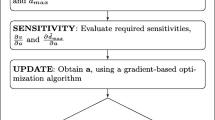Abstract
This work presents a methodology for the optimal design of frame structures with elevation irregularity equipped with fluid viscous dampers. Irregular structures became more prevalent in the past few decades due to architectural and functionality considerations. However, from an engineering point of view, they are more challenging to design. Irregular structures are characterized by a drastic change in strength, stiffness and/or mass. Therefore, significant inter-story drifts and plastic deformation are expected in the relevant stories. One of the common design strategies to control the structural response is to integrate energy dissipation devices. In this paper, an approach for the simultaneous design of the force-resisting system and the energy dissipation devices is presented. A mixed-integer optimization problem aims to minimize the cost is formulated. Nonlinear Response History Analysis (NRHA) is adopted to assess the dynamic response of the frame, accounting for both the nonlinear behavior of the structure and the dampers. The optimization process is carried out using an evolutionary optimization approach, the well-known Genetic Algorithm (GA). A numerical example shows the robustness of the proposed optimization strategy.
Access this chapter
Tax calculation will be finalised at checkout
Purchases are for personal use only
Similar content being viewed by others
References
Gluck N, Reinhorn AM, Gluck J, Levy R (1996) Design of supplemental dampers for control of structures. J Struct Eng 122(12):1394–1399. https://doi.org/10.1061/(ASCE)0733-9445(1996)122:12(1394)
Lopez Garcia D, Soong TT (2002) Efficiency of a simple approach to damper allocation in MDOF structures. J Struct Control 9(1):19–30. https://doi.org/10.1002/stc.3
Singh MP, Moreschi LM (2002) Optimal placement of dampers for passive response control. Earthq Eng Struct Dyn 31(4):955–976. https://doi.org/10.1002/eqe.132
Pollini N, Lavan O, Amir O (2017) Minimum-cost optimization of nonlinear fluid viscous dampers and their supporting members for seismic retrofitting Nicolò. Earthq Eng Struct Dyn 46(12):1941–1961. https://doi.org/10.1002/eqe
Takewaki I (1997) Optimal damper placement for minimum transfer functions. Earthq Eng Struct Dynam 26(11):1113–1124
Lavan O, Levy R (2005) Optimal design of supplemental viscous dampers for irregular shear-frames in the presence of yielding. Earthq Eng Struct Dyn 34(8):889–907. https://doi.org/10.1002/eqe.458
Lavan O, Levy R (2006) Optimal peripheral drift control of 3d irregular framed structures using supplemental viscous dampers. J Earthq Eng 10(6):903–923. https://doi.org/10.1080/13632460609350623
Ganzerli S, Pantelides CP, Reaveley LD (2000) Performance-based design using structural optimization. Earthq Eng Struct Dyn 29(11):1677–1690. https://doi.org/10.1002/1096-9845(200011)29:11%3c1677::AID-EQE986%3e3.0.CO;2-N
Chan CM, Zou XK (2004) Elastic and inelastic drift performance optimization for reinforced concrete buildings under earthquake loads. Earthq Eng Struct Dyn 33(8):929–950. https://doi.org/10.1002/eqe.385
Fragiadakis M, Papadrakakis M (2008) Performance-based optimum seismic design of reinforced concrete structures. Earthq Eng Struct Dyn 37(6):825–844. https://doi.org/10.1002/eqe.786
Lavan O, Wilkinson PJ (2016) Efficient seismic design of 3D asymmetric and setback RC frame buildings for drift and strain limitation. J Struct Eng 04016205. https://doi.org/10.1061/(ASCE)ST.1943-541X.0001689
Viti S, Cimellaro GP, Reinhorn AM (2006) Retrofit of a hospital through strength reduction and enhanced damping. Smart Struct Syst 2(4):339–355. https://doi.org/10.12989/sss.2006.2.4.339
Takewaki I (1999) Displacement-acceleration control via stiffness-damping collaboration. Earthq Eng Struct Dyn 28(12):1567–1585. https://doi.org/10.1002/(SICI)1096-9845(199912)28:12%3c1567::AID-EQE882%3e3.0.CO;2-1
Cimellaro GP (2007) Simultaneous stiffness-damping optimization of structures with respect to acceleration, displacement and base shear. Eng Struct 29(11):2853–2870. https://doi.org/10.1016/j.engstruct.2007.01.001
Lavan O, Cimellaro GP, Reinhorn AM (2008) Noniterative optimization procedure for seismic weakening and damping of inelastic structures. Pacific Earthq Eng Res Cent 9445(November):2004–2008. https://doi.org/10.1061/(ASCE)0733-9445(2008)134
Lavan O (2015) A methodology for the integrated seismic design of nonlinear buildings with supplemental damping. Struct Control Heal Monit 19(1):88–106. https://doi.org/10.1002/stc
Rutenberg A (1981) A direct p-delta analysis using standard plane frame computer programs. Comput Struct 14(I):97–102
Spacone E, La R, Filippou FC (1992) A beam element for seismic damage analysis, no. August 19921–110
Levy R, Lavan O (2006) Fully stressed design of passive controllers in framed structures for seismic loadings. Struct Multidiscip Optim 32(6):485–498. https://doi.org/10.1007/s00158-005-0558-5
Acknowledgements
This research was supported by the Israeli Ministry of Housing and Construction through the National Building Research Institute grant # 2028281. The authors are grateful for this support.
Author information
Authors and Affiliations
Corresponding author
Editor information
Editors and Affiliations
Rights and permissions
Copyright information
© 2022 The Author(s), under exclusive license to Springer Nature Switzerland AG
About this paper
Cite this paper
Idels, O., Lavan, O. (2022). Design of Irregular Frames with Fluid Viscous Dampers Using Optimization. In: Bento, R., De Stefano, M., Köber, D., Zembaty, Z. (eds) Seismic Behaviour and Design of Irregular and Complex Civil Structures IV. Geotechnical, Geological and Earthquake Engineering, vol 50. Springer, Cham. https://doi.org/10.1007/978-3-030-83221-6_11
Download citation
DOI: https://doi.org/10.1007/978-3-030-83221-6_11
Published:
Publisher Name: Springer, Cham
Print ISBN: 978-3-030-83220-9
Online ISBN: 978-3-030-83221-6
eBook Packages: Earth and Environmental ScienceEarth and Environmental Science (R0)




